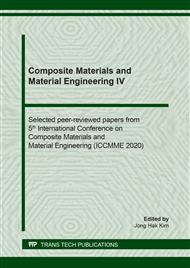
The oldest known concrete boat using steel wire mesh covered with sand and cement plaster was a dingy built by Joseph Louis Lambot Southern France in 1848. The boat was patented and featured in the 1855 World's Fair in France. In this study, the concrete boat using fiber wire mesh covered with cement, rice husk, silica fume, steel fiber, glass fiber wire, sand, water and superplasticizer was design and built in the material laboratory at Chaoyang University of Technology. The length, width, depth and thickness of the boat are about 60, 20, 10 and 1.5 cm respectively. The rice husk can absorb water ranging from 8% to 12% of unit weights, and the unit weight of rice husk is about 105 kg/m3. The use of rice husk in concrete at proportions ranging from 15 percent to 30 percent of aggregate (sand) has been discussed and the water cement ratio is 0.5. The rice husk concrete was found to be workable with a slump value of over 100mm. The incorporation of rice husk in concrete resulted in increase water demand and increased strength. Finally, the concrete boat succeeded to pass the floating waterproof qualifications and attend the remote control tests. The buoyancy is equal to 33.52 N and her waterline, where the hull of a boat meets the surface of the water, is approximately 6 cm. The remote control tests were held in 3 consecutive items, first item for speed tests, second item for maneuver tests, and third item for 30 minute field test remote control driving.
You might also be interested in these eBooks
Info:
© 2020 Trans Tech Publications Ltd. All Rights Reserved
[1]
L.C. Zaleski-Zamenhof, B.C. Gerwick, J. Hellesland, M. Matsuishi and X. Zhang: Concrete marine structures: A state-of-the-art review, Marine Structures Vol. 3-3 (1990), pp.199-235.
DOI: 10.1016/0951-8339(90)90026-n
Google Scholar
[2]
Karol Niklas, Janusz Kozak: Experimental investigation of Steel–Concrete–Polymer composite barrier for the ship internal tank construction, Ocean Engineering Vol. 111-1 (2016), pp.449-460.
DOI: 10.1016/j.oceaneng.2015.11.030
Google Scholar
[3]
Nusa Setiani Triastuti, Noraya Soewarno: Innovative use of Reinforced Concrete for Sustainability of Purse Seine Boat Building in Aceh, Procedia Engineering Vol. 125 (2015), pp.899-904.
DOI: 10.1016/j.proeng.2015.11.081
Google Scholar
[4]
F. Paradis, G. Gendron: Structural modeling and testing of a concrete canoe, Ocean Engineering Vol. 34-1 (2007), pp.206-217.
DOI: 10.1016/j.oceaneng.2006.01.006
Google Scholar
[5]
Maxim Morency and Francois Paradis: Lightweight Shotcrete Canoe: Use of Viscosity Modifying Admixture and Acetone as Artificial Paste, Journal of Materials in Civil Engineering Vol. 18-3 (2006), pp.361-366.
DOI: 10.1061/(asce)0899-1561(2006)18:3(361)
Google Scholar
[6]
Maurice E. Ephraim, Godwin A. Akeke and Joseph O. Ukpata: Compressive strength of concrete with rice husk ash as partial replacement of ordinary Portland cement, Scholarly Journal of Engineering Research Vol. 1-2 (2012), pp.32-36.
Google Scholar
[7]
Hamid Sarlak, Saeideh Abshenas: Design and construction of a remote control composite boat, Internal report – Team Zoubin (2008), Information on https://www.researchgate.net/ publication/272177566.
Google Scholar
[8]
Future With A Promise For Concrete Boat Building, Information on https://www.concreteconstruction.net/how-to/materials/future-with-a-promise-for-concrete-boat-building_o.
Google Scholar
[9]
Mbunwe Muncho Josephine: Design and Construction of a remote control switching device for household appliances application, Advances in Science, Technology and Engineering Systems Journal Vol. 2-4 (2017), pp.154-164.
DOI: 10.25046/aj020421
Google Scholar


